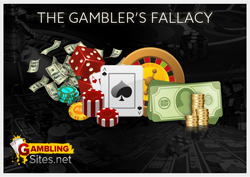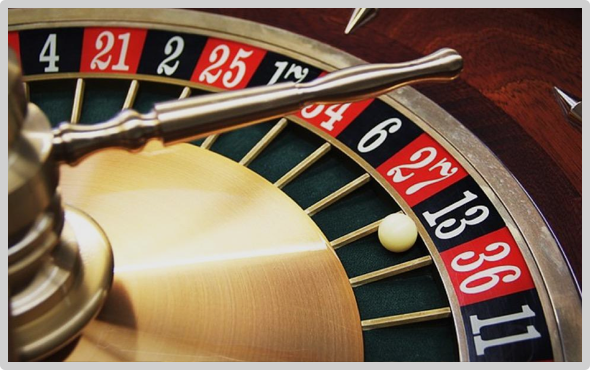The Gambler’s Fallacy
 In mathematical terms, a fallacy is defined as:
In mathematical terms, a fallacy is defined as:

That definition comes from the Oxford Dictionary of Current English. I use that dictionary because it’s the one Google uses for its definitions service.
I’m not sure that even this user-friendly definition does The Gambler’s Fallacy justice.
We should refer to it as an erroneous way of thinking about statistics. It just happens to be one that is very common (or at least expresses itself most often) among gamblers.
The basis of this line of thinking is a belief that a random outcome is either more or less likely to occur after the occurrence of another random event or series of events.
The reason this represents a “failure in reasoning” is that past events do not impact the probability of future events.
The worst possible mindset for casino gamblers – the idea that you simply have to “win back” any losses your experience at some point – is in fact a direct result of widespread belief in this fallacy.
For that reason, and because any knowledge about casino mathematics is a weapon against the casino’s edge, I want to break down The Gambler’s Fallacy and explain why it doesn’t work.
A Brief History of The Gambler’s Fallacy
This flawed method of reasoning is sometimes called the Monte Carlo Fallacy because of a famous example of widespread use of this bad logic during a series of roulette outcomes at Monte Carlo. According to a number of sources, the infamous roulette series occurred on August 18, 1913.
The outcome began to come up “black” several times in a row.
According to the book How to Take a Chance by Darrell Huff & Irving Geis, bettors started doubling and tripling their wagers on red around the time the fifteenth black result came in.

By the time the twenty-sixth black result appeared, bettors had lost “millions of francs” betting against black.
Their logic? – The “streak” of black outcomes had to end, because it wasn’t a random series.
Statistical Independence
A fancy phrase exists that’s relevant to this discussion: statistical independence.
Statistically-independent events are two that have no statistical effect on one another.
For example, I can think of two things that happened to me this morning while getting ready for work. I had a new tea blend with breakfast and I saw the first hummingbird of the season at my window feeder.
These events display statistical independence, because their independent occurrences had no impact on each other.
If they did, I could have the same cup of tea and watch a hummingbird at my window any time I want. Or maybe, every time I saw a hummingbird I’d get an overwhelming urge to drink tea.
That’s just not the case.
Statistical independence is not exactly the same as randomness. This is geeky math stuff, but it’s important to understand.
A sequence is random when its parts are statistically-independent of one another.
The perfect example is the venerable coin-flip.
Coin flips are truly random because the possible outcomes (“heads” or “tails”) are statistically-independent. You cannot predict (better than the 50/50 chance afforded you from the existence of just two options) what the next outcome will be based on a knowledge of the previous outcomes.
If you want to understand a little more about statistical independence, try this little experiment I’ve devised.
Complete both lists of numbers with the number you think will appear next in the sequence.

This set of numbers is probably familiar to you.
They are the first five “odd numbers” from the number line, and it’s obvious that the next number should be “11.”
The only reason we can predict the next number is because we have seen “behind the curtain.”
We know what to expect because we know the system the sequence is making a reference to.
Now try to predict the next number in this series:

You have almost no chance of picking the next number in this sequence because I’ve pulled these numbers at random from a list of personal contacts on my phone.
In order to know the next number in the sequence, you’d have to be sitting here with me while I go through the list.
You’d have to have inside information to guess the next result, because each outcome is independent of the others.
Believe it or not, that simple random number line is similar to the way random number generators produce mathematically-“random” results to simulate real-world random events.
Common Use of The Gambler’s Fallacy
You’ll often hear gamblers who have fallen victim to this line of thinking use the word “due,” as in “[specific outcome] is due to happen.” They say this because a game’s recent outcomes are different from what they expect.
You see two basic uses of this classic misunderstanding of gambling math. They share a big similarity – in both, bettors are making bad assumptions about future outcomes based on the past.
The first common form of The Gambler’s Fallacy takes us back to the coin-flip example.

Understand that each time the coin is tossed, it has a 50% chance of landing heads and a 50% chance of landing tails.
If a person flips the coin five times and sees the same outcome each time, he may decide that the next flip of the coin will produce a “tails” result, since “tails” is “due.” The reality is that the sixth toss has the same chances of landing heads or tails as the previous five.
The other common form of this line of thinking involves events which are not statistically-independent. I’ve found that this type of fallacy is far more common than the first among regular gamblers, but it’s just as bad a way to think about math.
 Imagine a football team has won it’s first ten games :
Imagine a football team has won it’s first ten games :In this case, the fact that the results of one match can, in fact, influence the outcome of another. It is because these events are dependent that the fallacy falls apart.
Why Do We Fall For The Gambler’s Fallacy?
My favorite description of this line of thinking is that it confuses the long-term with the short-term.
People know that a coin flip should produce an even number of heads and tails, so when (over the course of just a few flips) the results aren’t random, they attempt to find patterns.
This is a deep-seated thing that probably has something to do with the human brain.
Scientists refer to these deep-seated human thinking and behavior patterns as “cognitive bias.” Like any other bias, they are difficult to deal with.
The best thing you can do to avoid feeling the sting of this and other fallacies is to educate yourself.
You’re already doing that by learning everything you can about the math behind gambling and this fallacy itself.
However, simple education about the nature of gambling math doesn’t appear to work well on a grand scale to combat this kind of thinking.
Beach & Swensson Study
A scientific study (Beach and Swensson, Journal of American Psychology, 1967) proved this. The researchers showed participants a shuffled deck of cards featuring simple shapes and asked them to guess what shape would appear next in the series.
One group was given no preparation at all. The other group was taught a quick lesson about gambling math ahead of time and were instructed NOT to rely on fallacies during the test.
Both groups performed identically, proving that the experimental group still based their number series predictions on The Gambler’s Fallacy or some version of it.

Is there no hope for humans? Are we destined to believe in this nonsense until we give all our money to the casino?
Here is another study that indicates that this isn’t quite the case:
Fischbein and Schnarch Study
Researchers Fischbein and Schnarch published results of a questionnaire in the Journal for Research in Mathematics in 1997 showing that we tend to be less susceptible to these logical hiccups as we get older.
They gave their questionnaire to five different groups of students in different grades – 5th, 7th, 9th, 11th, and a group of college-level students who were trained in higher math.
They were asked the following question: “Ronnie flipped a coin three times and in all cases heads came up. Ronnie intends to flip the coin again. What is the chance of getting heads the fourth time?”
Obviously the correct answer is: 50%. Each flip of the coin is an independent event, so both results have a 50% chance of occurring.
According to the study, as students got older they stopped answering incorrectly, according to fallacious logic, and started to give the right answer.
This study was important not just among gamblers but among neuroscientists and psychologists as well. It is seen as proof that cognitive bias can be overcome with age, experience, and education.
Are All Attempts at Predicting Outcomes Wrong?
It is possible to make educated predictions about events, independent or not.
Any evidence-based prediction is probably a good one, and it is possible to make evidence-based assessments of all betting propositions, no matter how simple or how complex.
Here’s an example – imagine again that you tossed five “heads” in a row.
It is totally reasonable for you to assume that your likelihood of tossing another series of five heads is smaller than your likelihood of tossing another series of two heads. That is good statistics and, while it
might not be all that valuable to the average bettor, it makes logical sense.
Being able to make a logic-based prediction requires some basic understanding of the laws of probability. This is also a good way to avoid falling prey to The Gambler’s Fallacy.
One of the nice side effects of learning about this and other fallacies is that you’ll be less of a sucker on the casino floor or at online gaming venues. After all, gambling systems are all based on this or some other logical fallacy.
Rather than wasting your cash trying to beat a random roulette wheel or dice throw at the craps table, you can spend a few minutes doing your own research and see how these fallacies work for yourself.
Trying to predict future outcomes based on nothing but knowledge of past events is a recipe for failure.

 MENU
MENU










